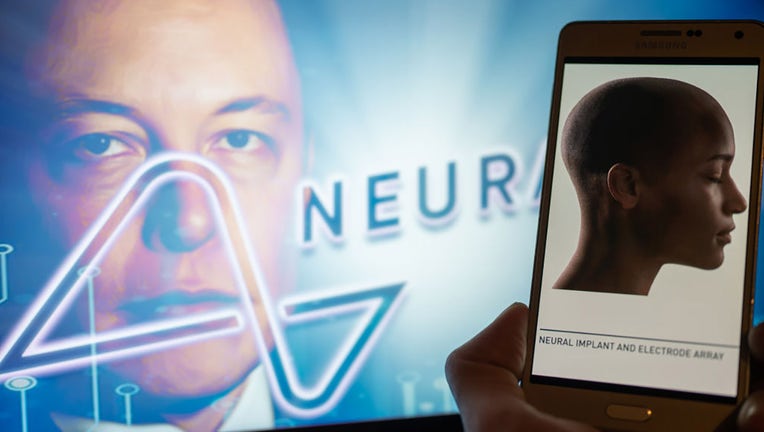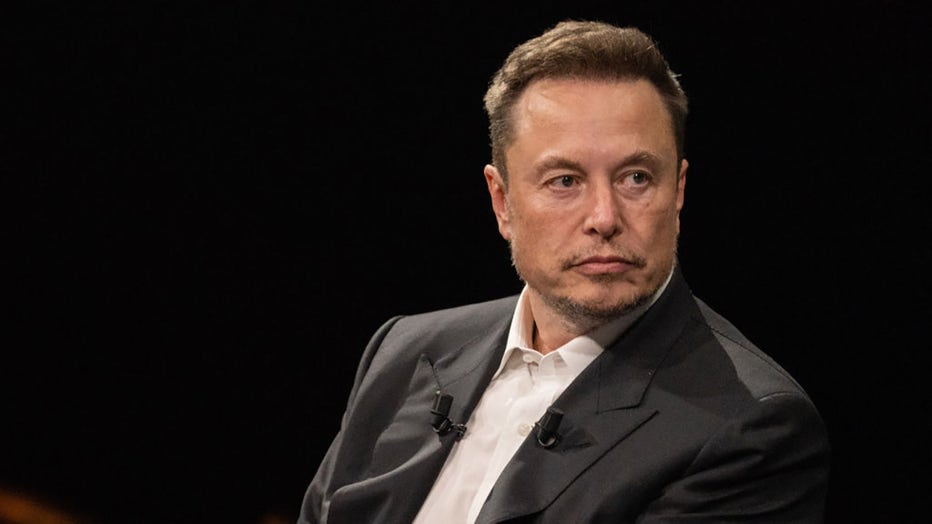Elon Musk’s Neuralink seeks 1st volunteer to have robot insert wires inside their skull

FILE - Neuralink logo displayed on a mobile with founder Elon Musk seen on screen in the background. (Photo Illustration by Jonathan Raa/NurPhoto via Getty Images)
SAN FRANCISCO - Elon Musk’s brain implant company Neuralink is seeking a volunteer who is willing to have a piece of their skull removed so that a surgical robot can insert electrodes and thin wires into their brain.
Neuralink, based in Fremont, California, is one of many groups working on linking the nervous system to computers – efforts aimed at helping treat brain disorders, overcoming brain injuries and other applications.
The ideal candidate to volunteer for Neuralink’s trial is a quadriplegic adult under age 40, the company told Bloomberg News. The device is about the size of a large coin and is designed to be implanted in the skull, with ultra-thin wires going directly into the brain.
The device is also meant to stay there for years, reading and analyzing the person’s brain activity, and then relaying that information wirelessly to a nearby laptop or tablet, according to Bloomberg News.
Brain-computer interface market is growing
If the product works as intended, future versions of the device could help millions of people suffering from paralysis, stroke, and other debilitating neurological conditions.
In addition to Neuralink, there are currently dozens of brain or spine computer interface trials underway, according to clinicaltrials.gov.
Researchers in Switzerland published research in the journal Nature earlier this year describing an implant that restores communication between the brain and spinal cord to help a man with paralysis to stand and walk naturally.
The global brain computer interface market was valued at $1.9 billion in 2022 and projected to reach $8.9 billion by 2032, according to the research firm Accumen Research and Consulting.
RELATED: Biden signs sweeping executive order on artificial intelligence development
How the Neuralink technology works
In May, Neuralink said it received approval for human clinical trials from the U.S. Food and Drug Administration. It’s still unclear how well this device or similar interfaces will ultimately work, or how safe they might be.
Musk – who is the CEO of Tesla and SpaceX – announced that Neuralink was ready to test its first implant on a human patient.
"The first human patient will soon receive a Neuralink device. This ultimately has the potential to restore full body movement," Musk posted on X, the social media platform formerly known as Twitter that he also owns.

FILE - Elon Musk, billionaire and chief executive officer of Tesla, at the Viva Tech fair in Paris, France, on Friday, June 16, 2023. Photographer: Nathan Laine/Bloomberg via Getty Images
Neuralink built its own 7-foot-tall surgical robot, equipped with cameras, sensors, and a tiny laser-milled needle, aiming to avoid creating any bleeding or scar tissue in a patient’s brain, according to Bloomberg.
Once a human surgeon cuts a hole in the patient’s skull, the robot then places 64 electrode-laced wires – or "threads" – into the brain while avoiding blood vessels.
As Bloomberg noted, no human surgeon would be able nor allowed to try this type of procedure with such precision required. Each electrode-laced wire is 5 microns thick, or about 1/14 the diameter of a strand of human hair.
Neuralink’s implant battery lasts a few hours and can be recharged wirelessly with a custom baseball cap, Bloomberg News reported.
The company says the goal is to enable the patient to complete computer-type functions using their thoughts through a "think-and-click" mechanism.
"The short-term goal of the company is to build a generalized brain interface and restore autonomy to those with debilitating neurological conditions and unmet medical needs," DJ Seo, a Neuralink co-founder and vice president for engineering, told Bloomberg News. "Then, really, the long-term goal is to have this available for billions of people and unlock human potential and go beyond our biological capabilities."
Neuralink’s robots have performed 155 of these surgeries on sheep, pigs and monkeys in 2021 and another 294 surgeries in 2022, according to the news outlet. Meanwhile, it has also faced federal scrutiny for its handling of animal testing.
"The last two years have been all about focus on building a human-ready product," Seo said. "It’s time to help an actual human being."
For surgeries on human patients, the preparation and craniectomy are expected to take a couple of hours, followed by about 25 minutes for the actual implantation, Bloomberg noted.
The current study of the device will take approximately six years, the company says in documents online. During this time, participants will have regular follow-ups to monitor progress and to ensure the device is working as intended.
The FDA has given Neuralink the OK to perform additional implant trials in 2024, Bloomberg reported. The company says it plans to perform 11 surgeries in 2024, 27 in 2025 and 79 in 2026 – then increasing exponentially in the years following, the news outlet reported, citing documents provided to investors.
RELATED: AI has ability to detect future heart attack: study
This story was reported from Cincinnati. The Associated Press contributed.

